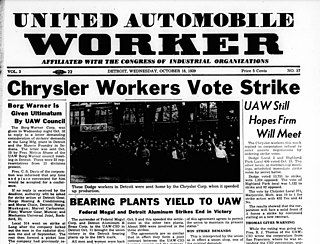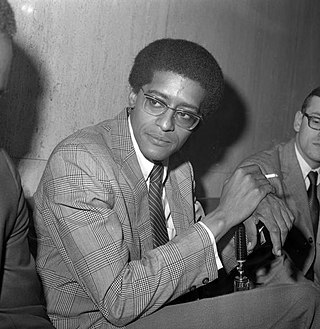Related Research Articles

Walter Philip Reuther was an American leader of organized labor and civil rights activist who built the United Automobile Workers (UAW) into one of the most progressive labor unions in American history. He saw labor movements not as narrow special interest groups but as instruments to advance social justice and human rights in democratic societies. He leveraged the UAW's resources and influence to advocate for workers' rights, civil rights, women's rights, universal health care, public education, affordable housing, environmental stewardship and nuclear nonproliferation around the world. He believed in Swedish-style social democracy and societal change through nonviolent civil disobedience. He cofounded the AFL-CIO in 1955 with George Meany. He survived two attempted assassinations, including one at home where he was struck by a 12-gauge shotgun blast fired through his kitchen window. He was the fourth and longest serving president of the UAW, serving from 1946 until his death in 1970.

The 1936–1937 Flint sit-down strike, also known as the General Motors sit-down strike, the great GM sit-down strike, and so on, was a sitdown strike at the General Motors plant in Flint, Michigan, United States. It changed the United Automobile Workers (UAW) from a collection of isolated local unions on the fringes of the industry into a major labor union, and led to the unionization of the domestic automobile industry.

The International Union, United Automobile, Aerospace, and Agricultural Implement Workers of America, better known as the United Auto Workers (UAW), is an American labor union that represents workers in the United States and Canada. It was founded as part of the Congress of Industrial Organizations (CIO) in the 1930s and grew rapidly from 1936 to the 1950s. The union played a major role in the liberal wing of the Democratic Party under the leadership of Walter Reuther. It was known for gaining high wages and pensions for auto workers, but it was unable to unionize auto plants built by foreign-based car makers in the South after the 1970s, and it went into a steady decline in membership; reasons for this included increased automation, decreased use of labor, movements of manufacturing, and increased globalization.

Douglas Andrew Fraser was a Scottish - American union leader. He was president of the United Auto Workers from 1977 to 1983 and an adjunct professor of labor relations at Wayne State University for many years.
Martin Glaberman was an American Marxist writer on labor, historian, academic, and autoworker.

Roland Jay Thomas, also known as R. J. Thomas, was a left-wing leader of the United Auto Workers in the 1930s and 1940s. He grew up in eastern Ohio and attended the College of Wooster for two years. The need to help support his family caused him to leave college and go to work. In 1923, he moved to Detroit, where he worked in a number of automobile plants.
The League of Revolutionary Black Workers (LRBW) formed in 1969 in Detroit, Michigan. The League united a number of different Revolutionary Union Movements (RUMs) that were growing rapidly across the auto industry and other industrial sectors—industries in which Black workers were concentrated in Detroit in the late 1960s and early 1970s. The formation of the League was an attempt to form a more cohesive political organ guided by the principles of Black liberation and Marxism-Leninism in order to gain political power and articulate the specific concerns of Black workers through political action. While the League was only active for a short period of time, it was a significant development in a time of increasing militancy and political action by Black workers and in the context of both the Black liberation and Marxist-Leninist movements in the United States.
Reuther's Treaty of Detroit was a five-year contract negotiated by trade union president Walter Reuther between the United Auto Workers (UAW) and General Motors in 1950. The UAW reached similar deals with the other members of the Big Three automakers, Ford Motor Company and Chrysler. The UAW agreed to a long-term contract, which protected automakers from annual strikes, and it gave up the right to bargain over some issues in exchange for extensive health, unemployment, and pension benefits; expanded vacation time; and cost-of-living adjustments to wages.
Richard Frankensteen was the first president of the "Automotive Industrial Workers Association" which merged into the United Auto Workers (UAW) He was elected vice-president of the UAW, where he played a major role until he was ousted in 1947. Although never a Communist Party member, he was a leader of the leftwing coalition led by R. J. Thomas and George P. Addes. It opposed to Walter Reuther, who defeated them in 1947.

Leon E. Bates Sr. was an American labor union leader with the United Auto Workers union (UAW) from 1937 to 1964 when he retired as an "International Representative" of the UAW. He was one of the first African-American union organizers to work for the "UAW-CIO".
The Alliance for Labor Action (ALA) was an American and Canadian national trade union center which existed from July 1968 until January 1972. Its two main members were the United Auto Workers (UAW) and the International Brotherhood of Teamsters, although it had some smaller affiliates.
B. J. Widick was an American labor activist in the United Auto Workers union and socialist movements.

Wyndham Mortimer was an American trade union organizer and functionary active in the United Auto Workers union (UAW). Mortimer is best remembered as a key union organizer in the 1937 Flint Sit-Down Strike. Mortimer was the First Vice President of the UAW from 1936 to 1939. A member of the Communist Party USA from about 1932, Mortimer was a critic of the efforts of the conservative American Federation of Labor to control the union and was a leader of a so-called "Unity Caucus" which led the UAW to join forces with the more aggressive Congress of Industrial Organizations (CIO).
General Gordon Baker Jr. was an American labor organizer and activist.

The Walter P. Reuther Library, Archives of Labor and Urban Affairs, located on the campus of Wayne State University in Detroit, Michigan, contains millions of primary source documents related to the labor history of the United States, urban affairs, and the Wayne State University Archives. The building is named for UAW President and Congress of Industrial Organizations President Walter Reuther.

The Chrysler Auto Strike began in October 1939 at the Dodge Main Plant in Detroit, Michigan, as a struggle between the Chrysler Auto manufacturer and The International Union, United Automobile, Aerospace and Agricultural Implement Workers of America, better known as the United Auto Workers (UAW).

Kenneth Vern "Ken" Cockrel Sr. was an American politician, prominent attorney, and revolutionary, community organizer, from the city of Detroit. Cockrel served as a member of Detroit's Common Council, from his swearing-in in 1978 until 1982. In addition to winning major cases representing poor and working class Detroiters, Cockrel rose to political prominence as he helped organize social and political movements, including the League of Revolutionary Black Workers and other radical black, Marxist formations.

Roy Louis Reuther was an American labor organizer. He was one of the leaders of the historic Flint sit-down strike that gave birth to the United Auto Workers (UAW). Along with his brothers Walter and Victor, he helped build the UAW into the most powerful industrial union in the United States. Later, as political director for the UAW, he spearheaded efforts to expand voter participation, and was deeply involved in the civil rights movement.
Nat Ganley, or Nat Kaplan, was socialist and then communist journalist who become a union organizer in the 1930s, particularly for the United Auto Workers of America and was tried and convicted in 1954 for violating the Smith Act.
References
- ↑ Glaberman, Martin (1969). "The Dodge Revolutionary Union Movement". International Socialism. 1st series (36). Retrieved 21 April 2016.
- ↑ "Dodge Revolution Union Movement Finding Aid".